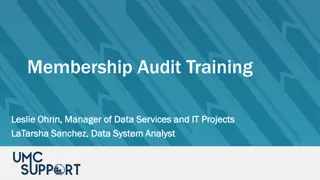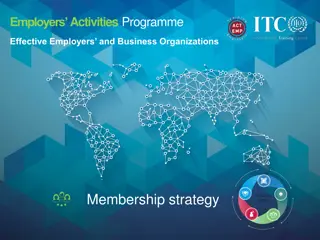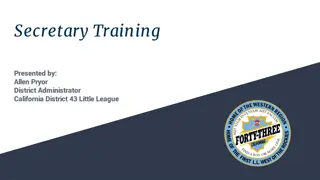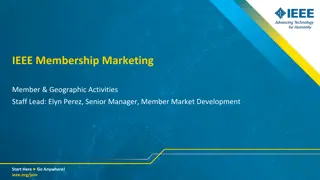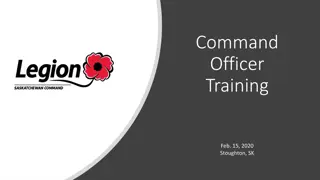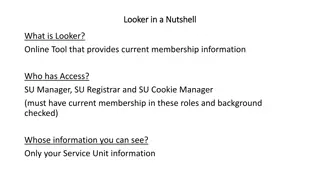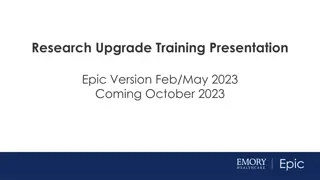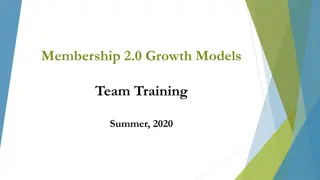
Accreditation Standards: Effective Approaches and Integration
Explore the essential elements of accreditation standards, including effective approaches, deployment consistency, progress assessment, and integration across processes. Learn how to meet standards through systematic evaluation and alignment with organizational needs.
Download Presentation

Please find below an Image/Link to download the presentation.
The content on the website is provided AS IS for your information and personal use only. It may not be sold, licensed, or shared on other websites without obtaining consent from the author. If you encounter any issues during the download, it is possible that the publisher has removed the file from their server.
You are allowed to download the files provided on this website for personal or commercial use, subject to the condition that they are used lawfully. All files are the property of their respective owners.
The content on the website is provided AS IS for your information and personal use only. It may not be sold, licensed, or shared on other websites without obtaining consent from the author.
E N D
Presentation Transcript
Accreditation Standards Member Training February 4, 2016
Meet Standards What does this mean?
Examined from four perspectives Approach Designing and selecting effective processes, methods, and measures Deployment Executing the approach with consistency Learning Assessing progress and capturing new knowledge, including seeking opportunities for innovation Integration Achieved when individual processes operate as a fully interconnected unit
Approach The methods used to carry out the process The appropriateness of the methods to the item requirements and the program s operating environment. The effectiveness of the methods The degree to which the approach is repeatable and based on reliable data and information (i.e. systematic)
Deployment The extent to which the approach is applied in addressing the requirements of the standard that are relevant and important to the SBDC program Executing the approach consistently The extent to which the approach is applied to all appropriate work units
Learning The refinement of the approach through cycles of evaluation and improvement The encouragement of change to the approach though innovation The sharing of refinements and innovations with other relevant work units and processes in the SBDC
Integration The approach is aligned with the SBDC needs identified in the Organization Profile The measures, information and improvement systems are complementary across processes and work units The plan, processes, results, analysis, learning, and actions are harmonized across processes and work units to support network-wide goals
Meets Standard An effective, systematic approach, responsive to the basic requirements of the item is evident (A) The approach is deployed, although some areas or work units are in early stages of deployment (D) A systematic approach to evaluation and improvement is evident (L) The approach is aligned with the SBDC needs identified in response to the Organizational Profile and other process items (I)
1.0 Leadership Objective: The SBDC has a governance system and environment that routinely addresses organizational values, ethical behavior and performance expectations.
1.1 Senior Leader Authority The SBDC Network Director has the authority to make decisions to lead, set strategic direction and sustain the network.
1.1 Senior Leader Authority Show how the network director: Received delegation of authority or PI designation Authority to manage financial and human resources Authority to determine the organization s structure and governance Manages in accordance with rules and regulations governing the program
1.2 (a) Sustainable Organization SBDC leaders routinely guide and sustain the organization, communicate with the workforce, encourage high performance work, advance organizational values, and promote ethical behavior.
1.2 (a) Sustainable Organization Describe how the leader: Sets and communicates the vision Focuses actions to achieve strategic objectives Encourages continuous improvement and progress toward their vision. Communicates & deploys expectations (*) Reviews performance, translates findings to learn and improve the SBDC (*) Promotes ethical behavior and manages potential conflicts of interest
1.2(b) Compliance The SBDC network operates in compliance with the laws and regulations governing the network.
1.2(b) Compliance Show: How compliance with laws and regulations is assured The processes to manage fiscal and contractual requirements Provide the results of past reviews and responses to findings/conditions Describe where the director s position fits in the host institution and the salary compares appropriately
1.2(c) Support the National SBDC Program The SBDC leaders support and participate in the common interest of the national SBDC program.
1.2(c) Support the National SBDC Program Examples to show this include: How the leaders participate on committees/board of the ASBDC Promotions of SBDC initiatives within the network Participation in surveys Provide presentations at conferences and/or send participants
2.0 Strategic Planning Objective: Develop, implement, modify and measure progress on a strategic plan that drives the SBDC network toward its established mission and vision.
2.1(a) Strategy Development Process The SBDC has a process to address its strategic challenges and leverage its strategic advantages and opportunities. The process, at a minimum, must include identifying, collecting and analyzing relevant information critical to achieving the program s vision.
2.1(a) Strategy Development Process State your network s vision, values and mission Describe the key steps in the planning process, participants and horizons Explain how data is analyzed to ID opportunities Explain how opportunities are identified and align with stakeholder needs How does analysis translate into services and products or new market opportunities (*) Describe the core competencies, financial and other resources needed to achieve the strategic priorities (*) How are key success factors identified
2.1(b) Strategic Priorities The strategic planning process identifies key strategic priorities, measures and timetables.
2.1(b) Strategic Priorities Describe: How the opportunities/challenges discovered in the planning process become your strategic priorities The priorities (*) The goals (*) Timetable to accomplish them (*) The services, client segments, markets and operational changes needed to reach the goals (*)
2.2 Strategy Implementation The SBDC has a process to deploy the strategic plan throughout the network, which includes identifying necessary resources, measuring progress and modifying objectives.
2.2 Strategy Implementation Describe: The actions needed to accomplish the strategic priorities (*) How those actions are deployed throughout the network The resources needed to deploy them (*) The measures to track progress (*) How plans are modified when necessary
3.0 Stakeholder and Customer Focus Objective: Identify and segment stakeholders and customers; determine their requirements, expectations and preferences for each; build relationships; and determine satisfaction
3.1 Stakeholder Engagement (Existing and Potential) 3.1 (a) Stakeholder Requirements and Expectations The SBDC understands the requirements and expectations of its key stakeholders and any new stakeholders.
3.1 Stakeholder Engagement (Existing and Potential) 3.1 (a) Stakeholder Requirements and Expectations Things to do: Name your key stakeholders and why they were selected (*) Explain how you understand your key stakeholders needs Explain how you get feedback to see if know you are meeting your stakeholders needs (*) Explain how you communicate the SBDC is meeting your stakeholder needs
3.1 Stakeholder Engagement (Existing and Potential) 3.1 (b) Stakeholder Relationships and Satisfaction The SBDC obtains information on key stakeholder satisfaction, dissatisfaction and engagement.
3.1 Stakeholder Engagement (Existing and Potential) 3.1 (b) Stakeholder Relationships and Satisfaction Things to do: Provide evidence of engagement (*) Show how you proactively seek feedback Explain how you analyzes feedback Explain what you ve done in response to feedback
3.2 Customer Engagement (Existing and Potential) 3.2 (a) Customer Requirements and Expectations The SBDC demonstrates how it defines and analyzes the requirements, expectation and preferences of customer segments and potential segments.
3.2 Customer Engagement (Existing and Potential) 3.2 (a) Customer Requirements and Expectations Things to do (*): Describe your customer segments and why you selected them Describe how you know your key customers needs and expectations in each segment Describe how your products and services meet each segment s expectations.
3.2 Customer Engagement (Existing and Potential) 3.2 (b) Customer Relationships and Satisfaction The SBDC obtains information on customer satisfaction, dissatisfaction and engagement.
3.2 Customer Engagement (Existing and Potential) 3.2 (b) Customer Relationships and Satisfaction Things to do (*): Describe how your customer relationships are managed and how you acquire new customers Explain how you proactively seek feedback Show how you analyze feedback Describe how you use the information to improve.
3.3 Marketing and Branding The SBDC has a clear integration of its marketing strategy and image that conveys the SBDC as a cohesive network that is part of the national SBDC program.
3.3 Marketing and Branding Things to do: Explain your policy on the proper use of the logo and other graphics Show how the logo and graphics are consistently used throughout the network Provide evidence that the network acknowledges it is an accredited member of the ASBDC
4.0 Measurement, Analysis and Knowledge Management Objective: The SBDC has a performance management system for driving and managing daily operations and for tracking overall organizational performance. This system includes measurement selection, data collection, date integrity, analysis and alignment with key strategic objectives.
4.1 Performance Measurement SBDC has a systematic process which identifies how it selects, measures, verifies and analyzes performance data. The SBDC analyzes trends in key performance measures and other operational data, and benchmarks against other organizations to support continuous improvement.
4.1 Performance Measurement Things to do: Key metrics named and why/how they were selected (*) Which metrics used to: Evaluate operational performance (every day activities) Evaluate overall organizational performance (consolidated measures over time and/or across centers) Leading and lagging indicators; and quantitative and qualitative (judgement / opinion) measures. How data is used to support organizational decision making and innovation
4.1 Performance Measurement (cont.) Things to do: How peer/competitor organizations were selected for comparative analysis Which measures are used for comparative purposes and why they were selected How data analysis is used to encourage innovation and organizational improvements
4.2 Data Integrity The SBDC has a systematic process to ensure data and information is accurate and impact is attributed by the client.
4.2 Data Integrity Things to do: Client attribution: clients state the SBDC assisted in their economic impact success New Business Starts Capital Acquisition (debt & equity funding) Changes in Sales Changes in Employees Methods used to assure data accuracy Amounts of impact documented by clients and/or third party authorities
4.3 Security and Confidentiality of Data The SBDC has a systematic process in place to maximize security and confidentiality of all customer information and other data.
4.3 Security and Confidentiality of Data Things to do: Note security measures used by Neoserra, Center IC or in-house Local back-up processes - at least one off-site back-up Virus/malware protection Laptop/home office security policies How files (electronic and paper) are stored
4.3 Security and Confidentiality of Data Things to do: Standards of Conduct/Client Confidentiality Statements (frequency/distribution/storage) Policies & procedures regarding Open Records Acts, if applicable in that state Public Relations Release Forms Other relevant policies on security and confidentiality of data
4.4 Economic Impact Participation The SBDC network participates in the impact studies of the America s SBDC and/or SBA and develops a process which strives to attain statistically significant number of useable responses while adhering to survey protocol and maintaining survey integrity.
4.4 Economic Impact Participation Things to do: Provide a copy of state/regional report, or if not available a copy of the national study indicating SBDC participants Show the response rate and tactics deployed to improve response rate/ensure statistically reliable response rate Show how you manage the survey process to maintain its integrity
5.0 Workforce Focus Objective: Create work systems and an environment that engages, manages, and develops the workforce to maximize its potential in alignment with the SBDC s strategic plan.
5.1 Workforce Capability and Capacity The SBDC has work systems, an organization structure and staffing patterns based on analysis of key needs and strategies of the SBDC. This structure must align with the SBDC s strategic priorties and be designed to enable the workforce to achieve desired results and effectiveness while providing an opportunity to develop its full potential and achieve high performance.
5.1 Workforce Capability and Capacity Things to do: oExplain how you assess staffing needs to include skills, competency and capacity(*). oDescribe how you recruit, hire and retain current workforce members oDescribe your core competencies and how they are used to meet expectations. oShow how you align workforce needs to achieve desired results






